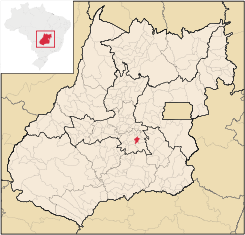
Senador Canedo
Encyclopedia
| Senador Canedo | |
|---|---|
| State | Goiás Goiás Goiás is a state of Brazil, located in the central part of the country. The name Goiás comes from the name of an indigenous community... |
| Area: | 244.7 km² |
| Population: | 70,559 (IBGE 2005) |
| Elevation: | 801m above sea level |
| Postcode (CEP): | 75250-000 |
| IBGE statistical microregion: | 010 Goiânia Microregion Goiânia Microregion The Goiânia Microregion is a region in central Goiás state, Brazil. It includes 17 municipalities with a population of 2,032,305 in a total area of 6,848.00 km².... |
| Became a city: | 1989 |
| Distance to Goiânia Goiânia -Climate:The city has a tropical wet and dry climate with an average temperature of . There's a wet season, from October to April, and a dry one, from May to September. Annual rainfall is around 1,520 mm.... : |
16 km. |
| Website: | Prefeitura Municipal de Senador Canedo |

City
A city is a relatively large and permanent settlement. Although there is no agreement on how a city is distinguished from a town within general English language meanings, many cities have a particular administrative, legal, or historical status based on local law.For example, in the U.S...
and municipality
Municipality
A municipality is essentially an urban administrative division having corporate status and usually powers of self-government. It can also be used to mean the governing body of a municipality. A municipality is a general-purpose administrative subdivision, as opposed to a special-purpose district...
in central Goiás
Goiás
Goiás is a state of Brazil, located in the central part of the country. The name Goiás comes from the name of an indigenous community...
state, Brazil
Brazil
Brazil , officially the Federative Republic of Brazil , is the largest country in South America. It is the world's fifth largest country, both by geographical area and by population with over 192 million people...
. It is the center of the petrochemical industry for the state.
Location
Senador Canedo is crossed by two state highways, GOs 020 and 010. It is located 16 kilometers southeast of the state capital of GoiâniaGoiânia
-Climate:The city has a tropical wet and dry climate with an average temperature of . There's a wet season, from October to April, and a dry one, from May to September. Annual rainfall is around 1,520 mm....
and is connected by GO-403
Senador Canedo is part of the Goiânia Microregion
Goiânia Microregion
The Goiânia Microregion is a region in central Goiás state, Brazil. It includes 17 municipalities with a population of 2,032,305 in a total area of 6,848.00 km²....
, which has more than 1,700,000 inhabitants.
Petrochemicals
The principal activity of the city is the petrochemical complex (Petrobras, Realpetro, Petrobol, Unip, Gasbal, and Sauro) , with several related industries near the city. It is also the headquarters of major industries like Goiás Carne, Curtume Centro-Oeste, Brasil Spuma, Cicopal, Mittel Klasse Farmacêutica, Q Vida Produtos de Limpeza, Mold Pré Moldados, Fertilizantes Solo Nobre, Queiroz Produtos Alimentícios and Arpec Equipamentos Limitados.It has a well-developed infrastructure in the transport sector, with a terminal for railroad cargo. Both the leather industry complex and the petrochemical complex were installed according to ecological concerns and there is a sewage treatment plant. Senador Canedo is one of the fastest growing cities in the state of Goiás
Goiás
Goiás is a state of Brazil, located in the central part of the country. The name Goiás comes from the name of an indigenous community...
.
Political Information
- Mayor: Vanderlan Vieira Cardoso (January 2005)
- Political coalition: PDT / PMDB / PL / PPS / PHS
- City council: 10 members
- Eligible voters: 44,492 (December/2007)
Demographic Information
- Population density: 288.3 inhab/km² (2007)
- Urban population: 67,900 (2007)
- Rural population: 2,659 (2007)
- Population growth: a gain of about 48,000 people since 1991
Economic Information
The economy is based on agriculture, services, public administration, and transformation industries. Much of the income is generated by the petrochemical installations.- Industrial units: 81 (2007)
- Commercial units: 416 (2007)
- Dairies: Agroindustrial Morada do Bosque Ltda (22/05/2006)
- Meat-packing plants: Coop. Ind. de Carnes e Derivados de Goiás Ltda (22/05/2006)
- Financial institutions: -- Banco Itaú S.A.
- Banco do Brasil S.A (08/2007)
- Cattle herd: 18,460 head (2006)
- Main crops: rice (120 hectares), bananas, sugarcane, oranges, tangerines, beans, manioc, corn (600 hectares), and soybeans (200 hectares).
Education (2006)
- Schools: 54
- Classrooms: 380
- Teachers: 852
- Students: 25,046
- Higher education: none
- Adult literacy rate: 90.0% (2000) (national average was 86.4%)
Health (2003)
- Hospitals: 1
- Hospital beds: 75
- Ambulatory clinics: 22
- Infant mortality rate: 27.70 (2000) (national average was 33.0)
Municipal Human Development IndexHuman Development IndexThe Human Development Index is a composite statistic used to rank countries by level of "human development" and separate "very high human development", "high human development", "medium human development", and "low human development" countries...
- MHDI: 0.729
- State ranking: 147 (out of 242 municipalities)
- National ranking: 2,447 (out of 5,507 municipalities)
For the complete list see Frigoletto.com

